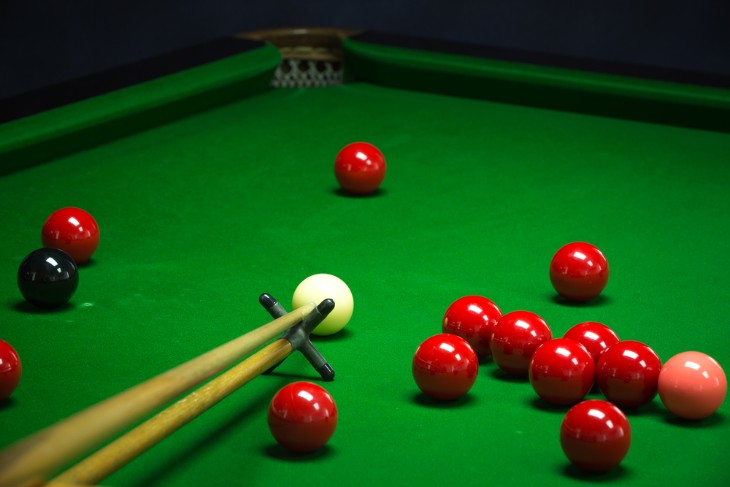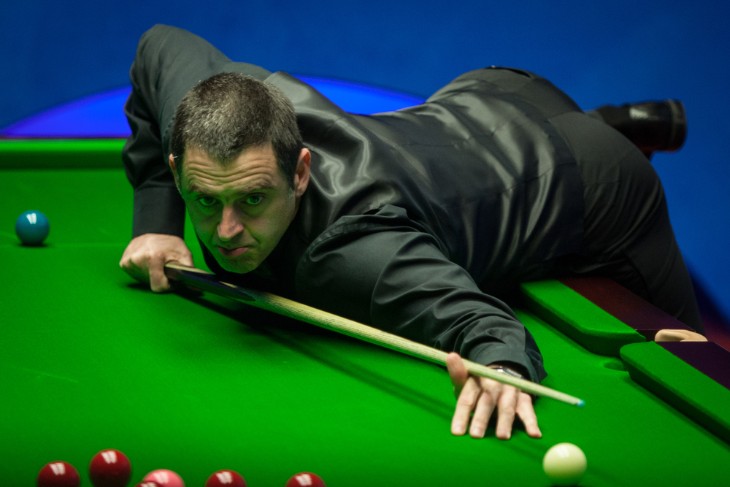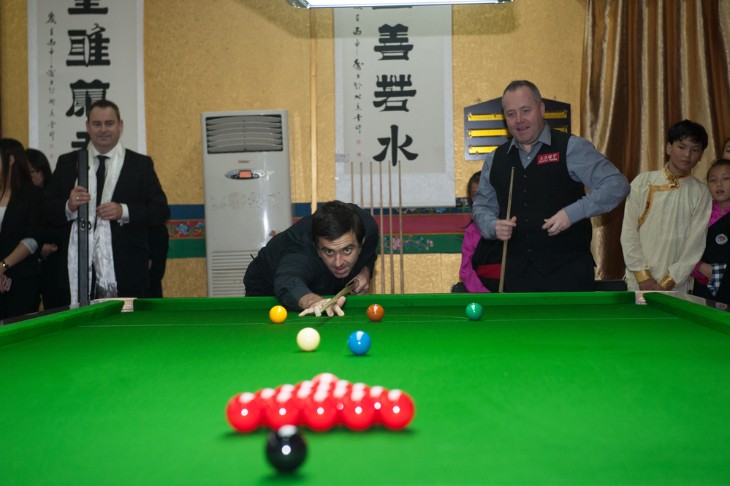Snooker is a sport where mastering the game is as much an art as it is a skill. Learning how to play snooker opens doors to a captivating blend of strategy, precision, and mental acuity. Join us as we explore the fundamentals and intricacies that define the captivating world of how to play snooker.
Understanding the Basics
Understanding these fundamental aspects of snooker—such as the table layout, equipment, game rules, and basic shots—is essential for beginners aiming to understand the game's dynamics and start their journey toward proficiency.
Snooker Table and Equipment
Understanding the Table: Snooker is played on a large rectangular table, typically measuring 12 feet by 6 feet. The surface is covered in a special cloth, known as baize, which provides a smooth playing surface. The table features six pockets, one at each corner and one in the middle of each long side. Specific markings, such as the baulk line and the D (a semicircular area behind the baulk line), are crucial for gameplay.
Balls Used in the Game: Snooker is played with 22 balls. There's the white cue ball, used to strike other balls, 15 red balls, and six differently coloured balls: yellow (2 points), green (3 points), brown (4 points), blue (5 points), pink (6 points), and black (7 points). The red balls are initially all placed in a triangular formation, called the 'pack,' while the coloured balls have designated spots on the table.
Rules of the Game
Objective and Scoring: The primary objective in snooker is to score points by potting (pocketing) balls legally. Players alternate turns, trying to pot red balls first, followed by any colour they choose. Each potted red ball earns one point, while colours have varying point values. After potting a coloured ball, it's re-spotted until all reds are off the table. The game ends when all balls are potted, and the player with the highest score wins.
Foul Penalties: Snooker has strict rules regarding fouls. Fouls occur when a player fails to hit a ball, pots the cue ball, or commits other violations. Penalties for fouls can result in point deductions, having to play from the current position, or allowing the opponent to have a free ball or reposition the cue ball.
Basic Shots and Execution
Potting: Potting involves striking a ball with the cue ball and sending it into one of the pockets. Achieving a successful pot requires accuracy, cue ball control, and understanding angles. Players must also consider positioning the cue ball for the next shot after potting a ball.
Safety Shots: Safety shots are essential strategies in snooker. These shots involve positioning the cue ball strategically to make it difficult for the opponent to pot a ball or set themselves up for their next shot. It may involve playing defensive shots or leaving the opponent in a challenging situation.
[promotion:173]
Setting Up and Getting Started
A. Initial Break-off
The commencement of a snooker game begins with the break-off shot, where one player strikes the cue ball from the 'D' area towards the triangular pack of red balls at the opposite end of the table. This shot sets the tone for the game, demanding precision and control. A well-executed break-off not only aims to make contact with the reds but also strategically positions the cue ball for subsequent shots. Players often aim to avoid leaving easy opportunities for their opponents.
B. Game Progression
As the game progresses, players alternate turns, attempting to pot the red balls initially. Once a red ball is potted, the player has the opportunity to aim for a coloured ball. The sequence follows a specific order of colours: yellow, green, brown, blue, pink, and black, each carrying different point values. The strategy in snooker lies not only in potting the balls but also in strategic decision-making. Choosing the right colours and planning subsequent shots is crucial for accumulating points and gaining control of the game.

C. Strategic Planning and Decision-Making
The essence of successful snooker play lies in strategic planning and astute decision-making. Players must plan not only their current shot but also anticipate subsequent shots. This foresight allows them to position the cue ball strategically for future plays. The decisions made during the game, whether to attempt a pot or play a safety shot, heavily influence the game's outcome. Players need to weigh risks versus rewards and adapt their strategies based on the evolving dynamics of the game.
D. Practicing Control and Precision
Controlled cue ball movement and precise potting are essential skills in snooker. Precision in potting demands consistent aim and execution. Meanwhile, controlling the cue ball's movement after striking is equally vital. Players should aim to position the cue ball for the next shot while denying easy opportunities for their opponents. Developing accuracy and control through practice allows players to enhance their overall gameplay.
E. Adapting Strategies
Adaptability is key in snooker. Players must be ready to adjust their strategies based on their opponent's style, skill level, and the game's progression. Flexibility allows for a seamless transition between offensive and defensive play, depending on the situation on the table. Being adaptable ensures players remain competitive and responsive to changing circumstances during the game.
F. Importance of Confidence
Confidence plays a significant role in successful snooker play. Building and maintaining confidence in one's skills and decision-making abilities is crucial. Confidence allows players to execute shots more effectively, even under pressure. Managing nerves and staying composed throughout the game contributes to a player's overall performance.
[promotion:1149]
Essential Techniques
A. Cueing Technique
Mastering the cueing technique is fundamental for snooker players. A proper stance is vital; it involves positioning the body comfortably, with one foot slightly ahead of the other for stability. The grip on the cue should be relaxed yet firm, allowing for control and precision. The bridge hand, supporting the cue on the table, must create a stable platform for a smooth and consistent stroke. Developing a consistent and accurate cue action is essential, ensuring the cue moves in a straight line and maintaining a fluid follow-through after striking the ball.
B. Basic Shots and Ball Control
Understanding the mechanics of potting is crucial. Players need to develop precise aim and control to successfully pot balls into the pockets. This requires not only accuracy in striking the object ball but also careful consideration of the cue ball's movement for positioning after the shot. Additionally, comprehending spin (topspin, backspin, and side spin) on the cue ball is essential. Different spins influence the cue ball's trajectory after contact with other balls, offering opportunities for advanced positional play and controlling the game flow.
C. Safety and Strategic Play
Safety shots are integral to snooker strategy. These shots involve positioning the cue ball in a way that makes it challenging for opponents to pot a ball or set themselves up for the next shot. Mastery of safety play requires foresight, and planning shots that both secure a player's position and create difficulties for their opponent. Implementing strategic play involves a mix of offensive and defensive tactics, making decisions that limit the opponent's options while setting up advantageous positions for oneself.
D. Cue Ball Control and English
Proficiency in controlling the cue ball is a hallmark of a skilled player. The ability to position the cue ball precisely for subsequent shots allows for strategic advantages and maintaining control of the table. Utilizing English, or side spin, on the cue ball introduces an advanced layer of control. This technique allows players to alter the cue ball's path and manipulate angles after contact with other balls, providing opportunities for intricate positional play and shot selection.
E. Mental Approach and Focus
The mental aspect of snooker is equally important as the physical skills. Players need to maintain focus throughout the game, concentrating on each shot while being aware of the overall game strategy. Patience is vital; snooker often demands waiting for the right opportunities to capitalize on. Building confidence, managing nerves, and staying composed under pressure are crucial mental attributes that contribute to consistent performance and success on the snooker table.
Advanced Strategies and Skills
A. Positional Play Mastery
Advanced players focus extensively on positional play, aiming not only to pot balls but also to position the cue ball precisely for subsequent shots. This involves intricate planning and execution to control the cue ball's path around the table. Understanding angles, deflection, and using cushions to navigate the cue ball to desired positions becomes paramount. Players strategize to leave themselves with ideal angles for easy access to the next ball.
B. Cue Ball Control and English Mastery
Adept players elevate their game by mastering cue ball control to an advanced level. This involves precise manipulation of the cue ball's path, using spin (English) to control both its trajectory and the path it takes after contact with other balls. Advanced players can execute complex shots involving multiple cushions, intricate positional play, and incorporating spin to achieve precise positional outcomes.
C. Safety Exemplification
At an advanced level, safety play becomes an art form. Skilled players not only play safety shots to protect their position but also use them strategically to force errors from opponents. This involves precise cue ball placement to make it difficult for the opponent to pot a ball or set up for their next shot. Advanced safety play often involves thinking several shots ahead to control the table and create opportunities.
D. Break-Building Strategies
Experienced players aim not only to pot balls but also to build substantial breaks. This requires the strategic potting of balls in a sequence that maximizes point scoring potential while ensuring optimal cue ball positioning for the next shots. Advanced players meticulously plan their break-building strategy, focusing on high-value colours while maintaining control of the table.
E. Tactical Awareness and Adaptation
Advanced players possess acute tactical awareness. They assess the table's layout, understand the significance of each ball's position, and adapt their game plan accordingly. This involves assessing risk versus reward for every shot, adjusting strategies based on the opponent's gameplay, and having the flexibility to switch between offensive and defensive play as the game unfolds.
F. Mental Fortitude and Consistency
Mental strength is vital at an advanced level. Players must maintain focus, composure, and confidence even during high-pressure situations. Consistency in performance, shot after shot, frame after frame, is key. Elite players excel not only in their technical skills but also in their ability to manage emotions, handle pressure, and maintain a clear mind throughout the game.

Mental Approach and Game Etiquette
A. Patience and Concentration
Patience: Learning how to play snooker is also learning how to be patient. Players often need to wait for the right opportunities to capitalize on, whether it's a chance to pot a crucial ball or to set up for a safety shot. Patience enables players to avoid rash decisions and play strategically, increasing their chances of success.
Concentration: Maintaining unwavering concentration is vital in snooker. Players must focus intensely on each shot, analyzing angles, and planning the cue ball's path. Distractions, even minor ones, can lead to errors that might cost a frame or match.
B. Sportsmanship and Etiquette
Respect for Opponents: Snooker etiquette emphasizes respect for opponents. Players should maintain a respectful attitude, avoiding unsportsmanlike behaviour or actions that could distract or disrupt the opponent's concentration.
Adherence to Rules: Adhering to the rules of the game is crucial. Honesty and integrity in acknowledging fouls or incorrect shots are essential. Players are expected to call fouls on themselves, even if the referee hasn't noticed.
C. Handling Pressure and Composure
Managing Pressure: Snooker can be mentally taxing, especially in high-stakes or competitive environments. Players must develop strategies to manage pressure, whether it's the pressure of a close match or a decisive shot.
Staying Composed: Maintaining composure, regardless of the situation, is vital. Even under immense pressure, elite players remain composed, ensuring clarity of thought and the ability to execute shots effectively.
D. Focus on Continuous Improvement
Learning from Mistakes: A strong mental approach involves learning from mistakes. Instead of dwelling on errors, players should use them as opportunities for growth and improvement.
Adaptability and Flexibility: The best players continuously adapt and refine their strategies. They remain flexible, adjusting their game plan as needed and seeking new approaches to enhance their skills.
E. Respect for the Game and Its Tradition
Respect for Tradition: Snooker is a game with a rich tradition. Players often demonstrate respect for the game's history and its traditions, showcasing a level of reverence for its heritage.
Promoting Sportsmanship: Encouraging fair play and good sportsmanship within the snooker community is important. Players often play a role in setting an example for younger or less experienced players regarding etiquette and respect for the game.
[promotion:1150]
Summary
The real pleasure of snooker, whether playing casually or competitively, comes from the journey towards mastery, a journey that blends skill, strategy, and a genuine love for the game.
For more information:





 (1).webp)






.webp)















